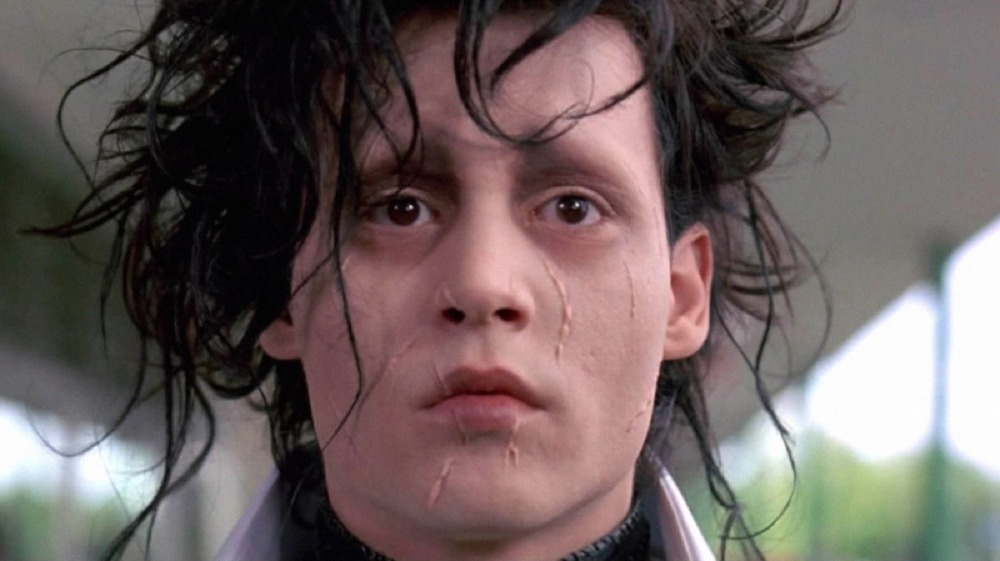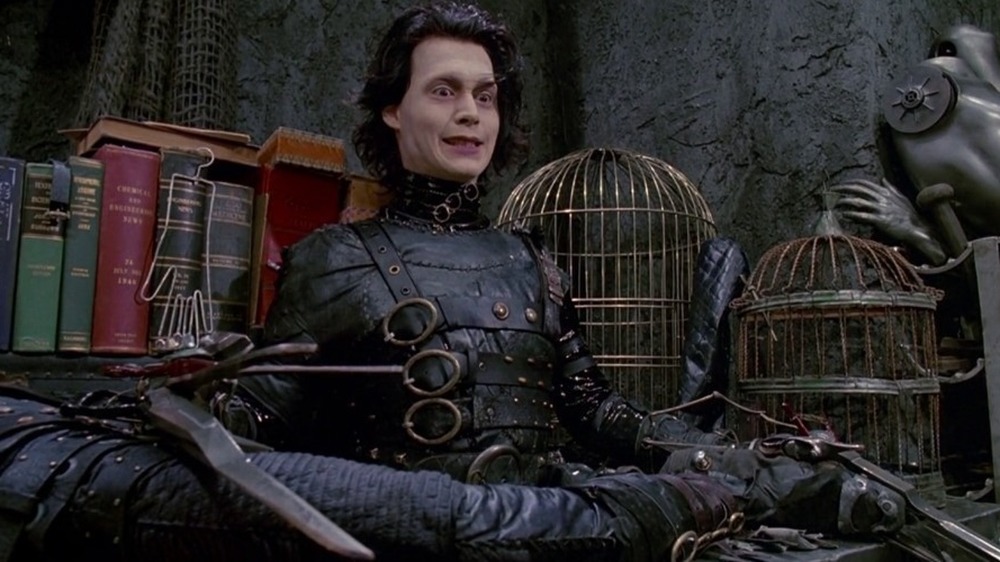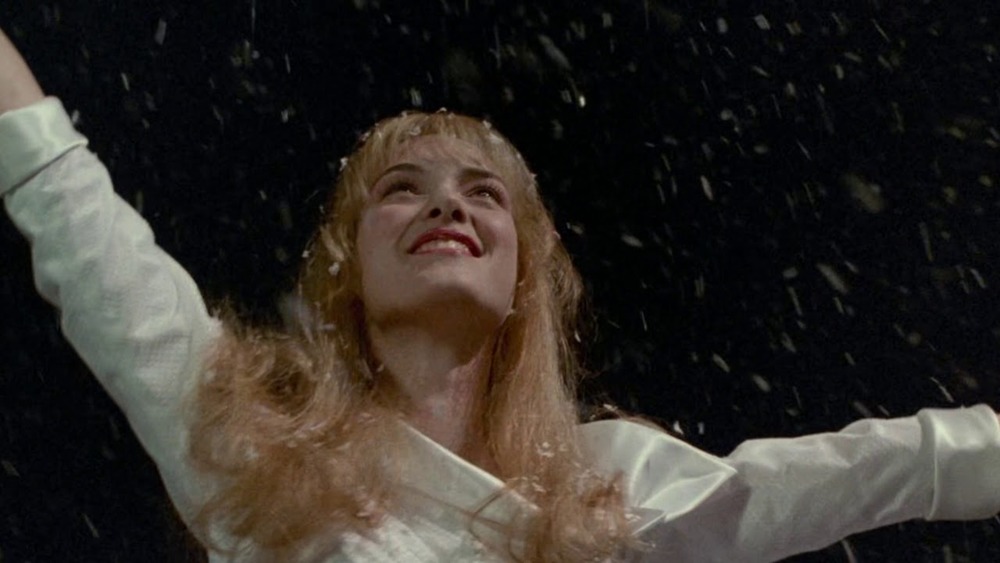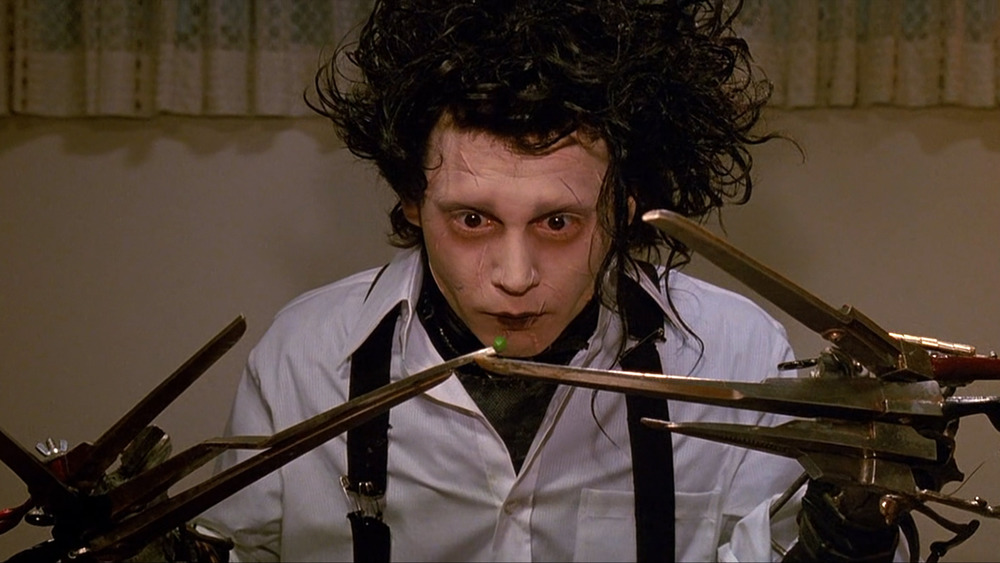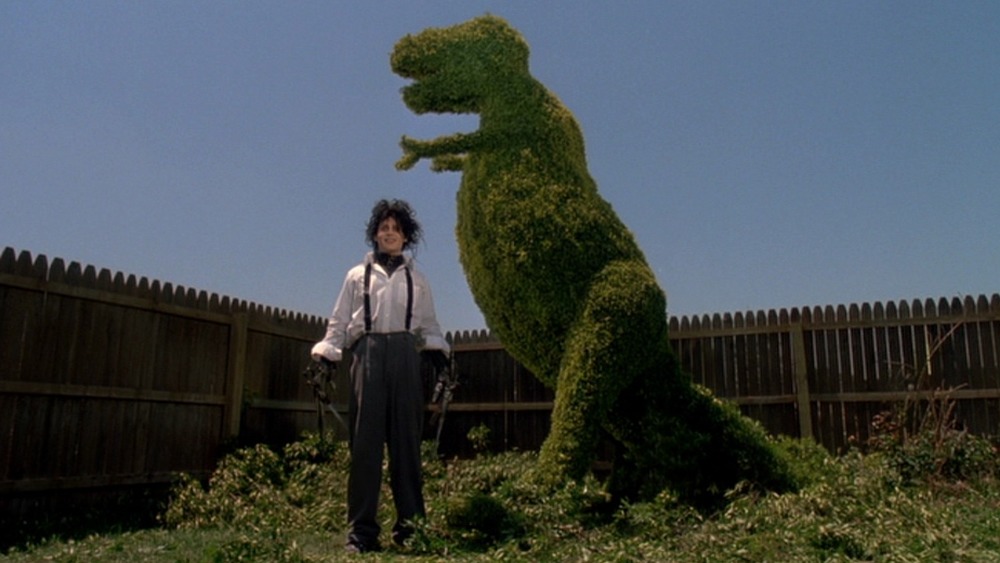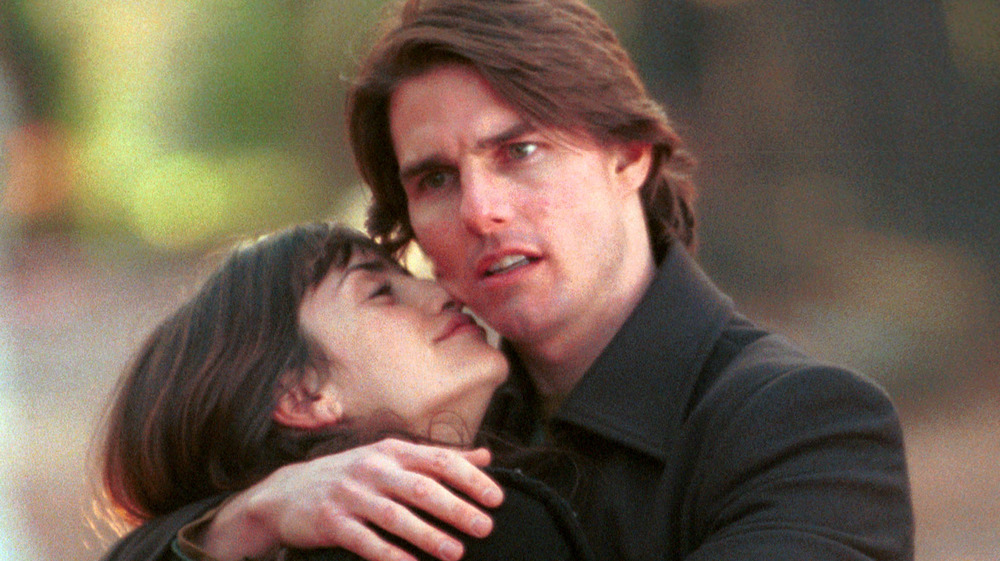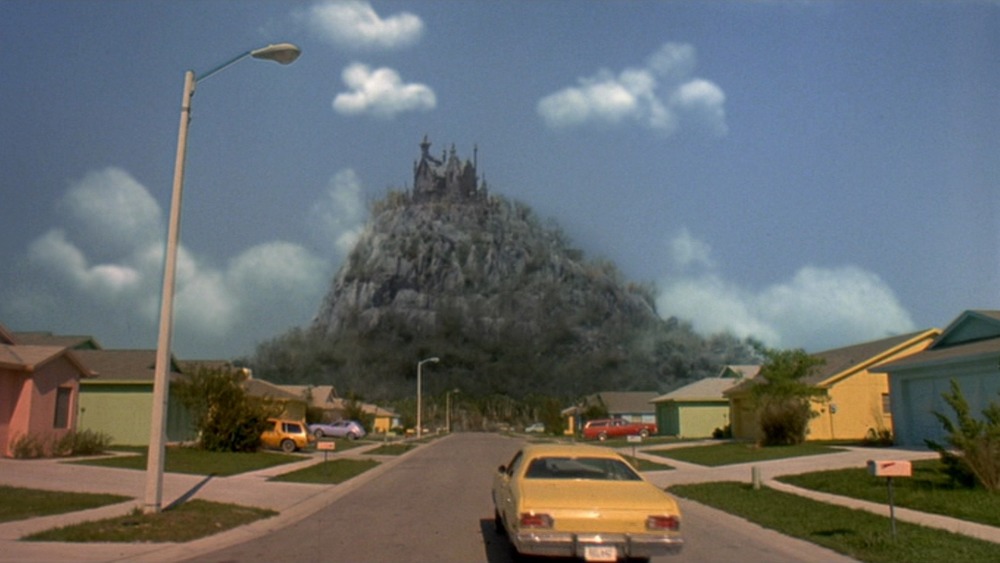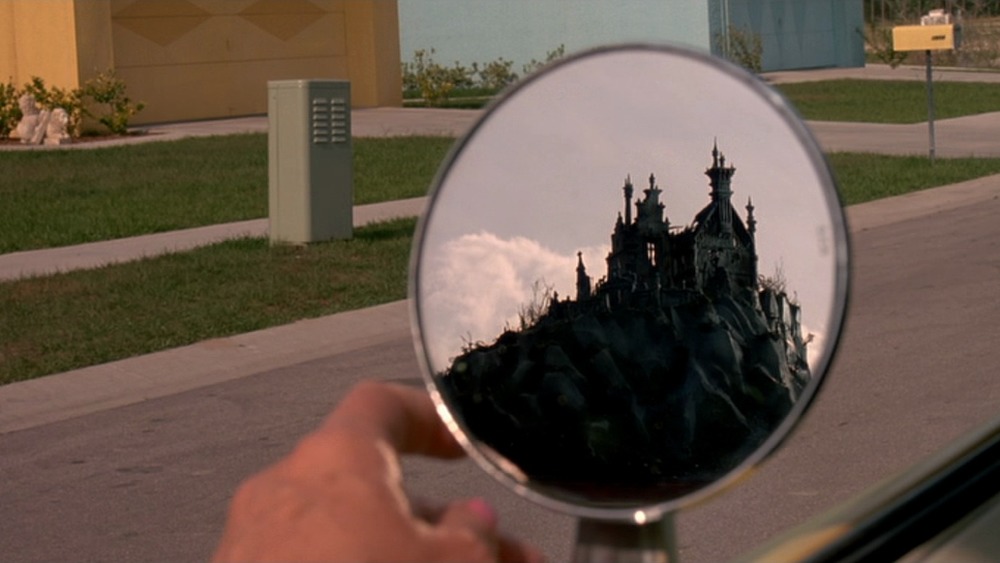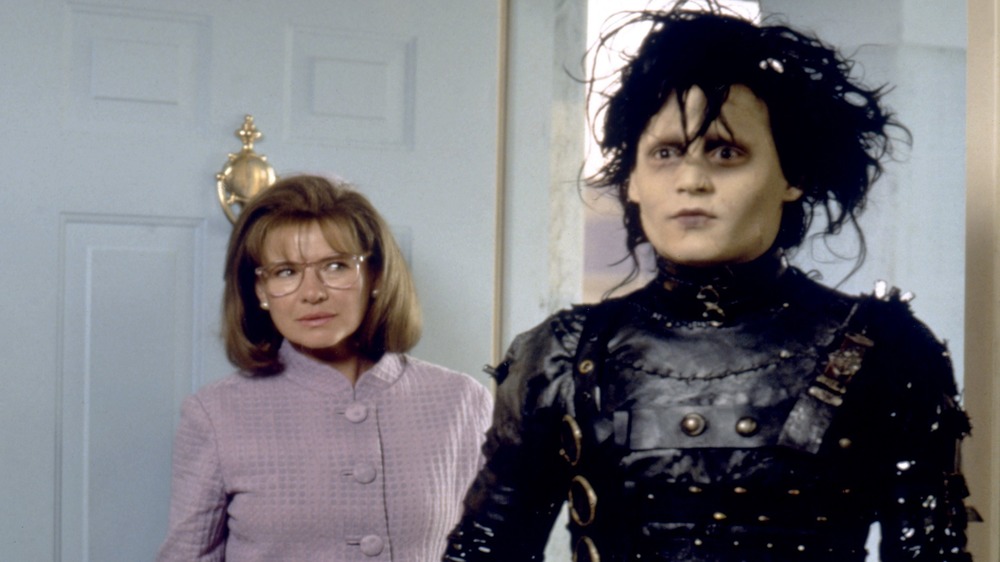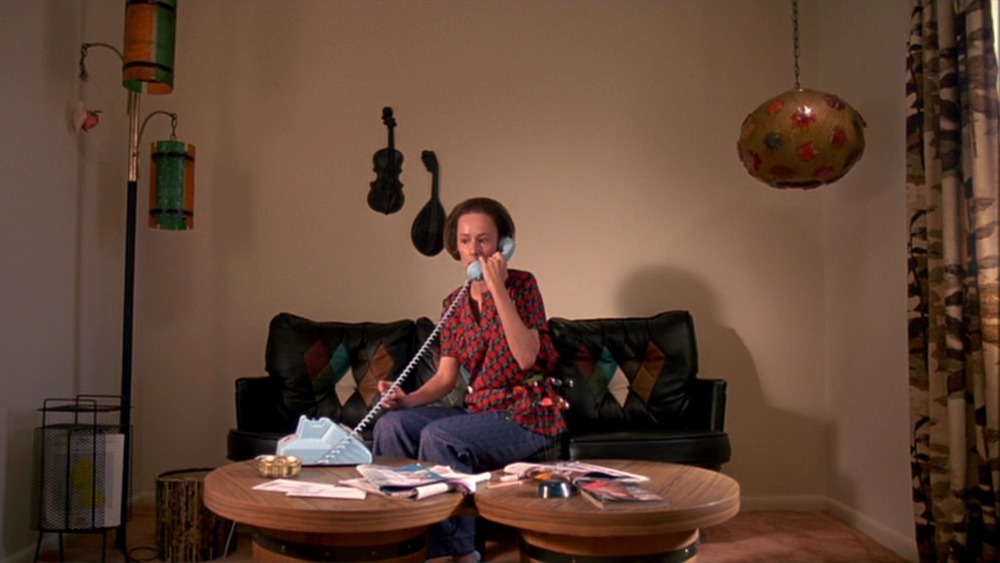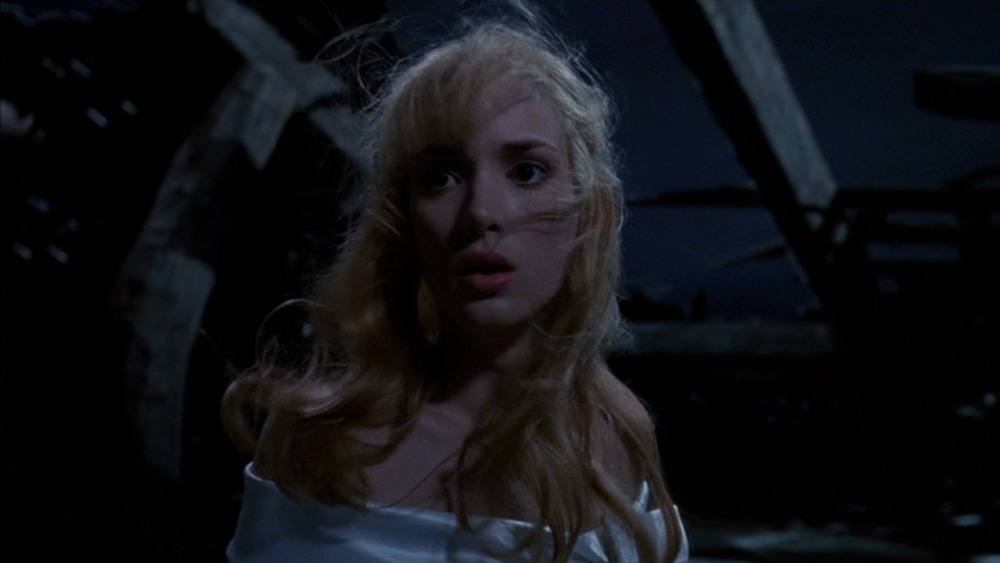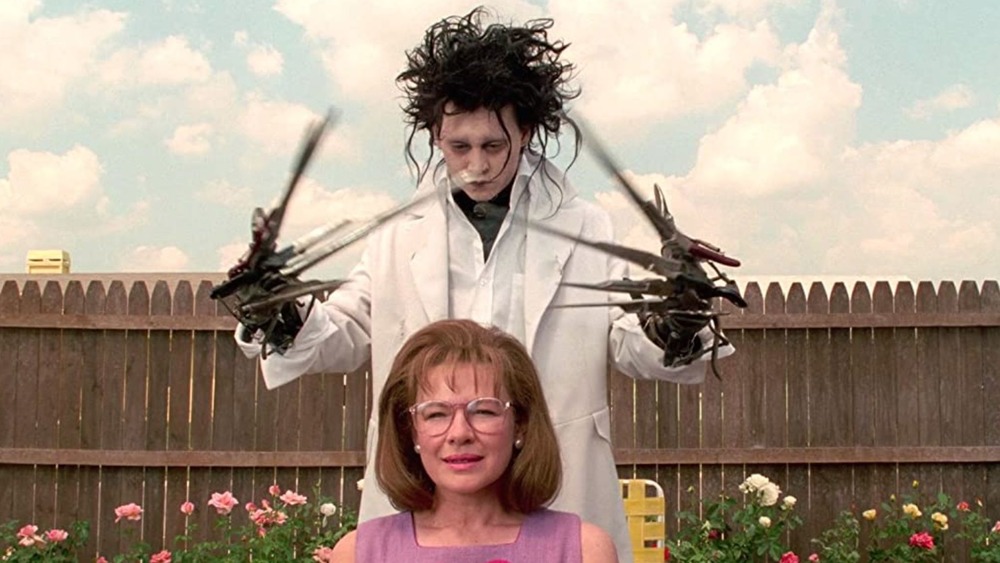The Untold Truth Of Edward Scissorhands
We've all felt lonely, misunderstood, ostracized, or isolated. Maybe that's why Edward Scissorhands has been so popular for so long. In one of his most personal films, director Tim Burton cast Johnny Depp, in the first of many movies they'd make together, as an artificial man who has scissors instead of hands because his creator (Vincent Price) died before he could finish him. He's discovered in the inventor's abandoned castle by a friendly Avon lady (Dianne Wiest) who introduces him to the world of American suburbia, where he's gawked at, embraced, and finally rejected. It's one of the few true fairy tales to come out of Hollywood, so full of symbolic resonance and wondrous imagery that it seems like it could've existed as one of the stories that the Brothers Grimm discovered being told around a hearth.
And there are plenty of stories behind Edward Scissorhands' creation, too. The mop-haired icon had a long journey to the screen, one full of might-have-beens, Hollywood gossip, and filmmaking ingenuity. We've sorted through them all for you, and we've provided the choicest cuts below.
Edward Scissorhands began life as a drawing by the teenaged Burton
Audiences may have first met Edward Scissorhands in 1990, but he lived a long, full life before he reached the screen. Tim Burton first doodled a sad-eyed young man with scissors for hands when he was only a teenager. "The manifestation of the image made itself apparent and probably came to the surface when I was a teenager because it is a very teenage thing," he says in Burton on Burton. He explained that, "It came subconsciously and was linked to a character who wants to touch but can't, who was both creative and destructive — those sorts of contradictions can create a kind of ambivalence."
In the home video's audio commentary, Burton adds, "Oftentimes images would stay with you, and you'd keep sort of drawing them. ... This is a character I ... thought about a lot, and I think sort of represented those years as a teenager when you're quite sort of intense and misperceived and, you know, those pretty classic things." That simple image of a character who literally can't reach out for affection without hurting someone, that very odd design that would be out of place wherever you placed him, haunted Burton throughout his education at CalArts, his stint as a Disney animator, and his early success and a director, before finally making its way to the screen.
Burton conceived Edward Scissorhands as a musical
Even when Tim Burton was preparing his creation for the screen, it wasn't in the form we eventually saw. Dazed Digital's oral history of Edward Scissorhands mentions that Burton initially saw the movie as a musical. Screenwriter Caroline Thompson admits, "In my prose treatment I wrote some really bad lyrics." And what were these songs about? Well, as Thompson elaborated, "For the story, I made a list of things to do with your hands that made it difficult for Edward at every turn. That was my MO for dealing with his differences. I remember the title of one [song], which was 'I Can't Handle This.'"
Fortunately, audiences never had to listen to those lyrics, however bad they might've been. Instead, Burton would make his first musical three years later when director Henry Selick adapted another of his long-gestating concepts as The Nightmare Before Christmas, and it would be over another decade before Burton took on his first live-action musical, Charlie and the Chocolate Factory.
Edward Scissorhands had the writer at 'scissorhands'
The story may have come directly from Burton's brain, but he still needed a writer to bring it to life (he hasn't written his own screenplay since his first short, Vincent). He found one in Caroline Thompson, whose novel First Born – another story about a picture-perfect suburb invaded by a strange, tortured creature when a mother is haunted by her unborn child — had suggested she might be a kindred spirit. Burton's instinct was right. As Thompson told Dazed, at their meeting in the LA coffee shop Bombay Bicycle Club, "Tim told me about a character he had who had scissors instead of hands, and I said, 'Stop right there. I know exactly what to do with that,' and went home."
Obviously, the image that had stuck in Burton's brain for so long stuck in hers, too. And this was, as they say in Casablanca, the start of a beautiful friendship. Thompson would go on to write two more Burton scripts – The Nightmare Before Christmas and Corpse Bride. It's hard to believe the story they created for Edward Scissorhands made it to the screen as a big-budget Hollywood movie with all its strangeness intact, but Burton and Thompson made a special arrangement to insure that it would. "I paid Caroline a few thousand dollars to write it so there was no studio involved," the director said in Burton on Burton. "We submitted it to studios as a package. ... It was a route I was determined to follow so no one could force changes on me."
Thompson found inspiration for Edward in her dog
Caroline Thompson went to work writing a story for Burton's strange, scissor-handed character and creating other characters to share the screen with him. And like many writers, she took these figures from her own life. The couple who adopts Edward were inspired by her own parents. Kim, the love interest who Winona Ryder brings to the screen, was based on Thompson's friend, Lori, while her bullying boyfriend, Jim (Anthony Michael Hall), was based on Lori's string of awful partners, with one in particular sticking out. "She had the most horrible boyfriend," the screenwriter said. "He was a bully — he was just that guy."
As for Edward himself, Thompson told Dazed, "He's ... based on Tim [Burton] who, at that time, was a largely non-verbal person. So we communicated by waving our hands at each other pretty much." That makes sense for such an obviously autobiographical creation, but her primary inspiration was much more unexpected — her dog, Ariel. That may look strange at first glance, but watching the movie, it makes perfect sense for Edward, with his desperate need to be loved and big puppy-dog eyes. And it helped Thompson's collaborators make sense of the character. As she explained,, "Johnny [Depp] said, 'I'm really confused about the tone. I'm confused about the character.' I told Johnny that the character was based on my dog, described her to him, then he goes 'Aha! I get it!' His performance changed completely after that."
Tom Cruise and Michael Jackson were up for the part
Before Johnny Depp signed on for his career-making role, many other names were under consideration. Dazed lists Jim Carrey, Tom Hanks, and Robert Downey Jr., any of whom could have made for a very different movie. Michael Jackson was also in the running, and despite his lack of acting experience, he certainly perfected the wide-eyed, soft-spoken man-child persona the role called for. Tom Cruise was also considered, who despite being the ultimate example of the "beautiful people" Edward could never fit in with, has an alien affect of his own that may have led to an intriguing performance.
But it wasn't meant to be. One disastrous meeting showed he had a much too literal outlook to inhabit Burton and Thompson's highly symbolic fairy-tale world. "[Cruise] wanted to know how Edward went to the bathroom," according to Thompson, "he was asking the kind of questions about the character that can't be asked for this character! ... Tom Cruise was certainly unwilling to be in the movie without those questions being answered." Fortunately, they found a star far closer to their wavelength with Depp, and while it's harder to believe in his innocence as Edward quite as much in light of the allegations against him, it's still an iconic performance that allowed him to pivot from 21 Jump Street pretty boy to Hollywood's favorite weirdo.
The Inventor's castle is based on the California Institute of the Arts
We first meet Edward when Avon lady Peg — after a long day with no luck selling door-to-door in her candy-colored, squeaky clean suburban neighborhood — decides to try the spooky old castle sitting on the hill above it. It's a surreal and unlikely image, but it came from real life. Burton explains in his commentary for the film that he based the Inventor's castle on his old school, the California Institute of the Arts.
Like Edward's birthplace, the school sits on a hill overlooking the suburban neighborhoods of Santa Clarita, California. Burton's far from the only cinematic alum to come out of the school. Nicknamed CalArts, it counts Walt Disney among its founders, and since its opening, it's sent the Disney studio a lot of its best talent, including many of Pixar's founders, the directors behind classics like Beauty and the Beast and Aladdin, Burton's Nightmare collaborator Henry Selick, and his favorite composer, Danny Elfman. One classroom in particular, A113, was so important to Pixar's crew that they've included references to it in nearly all their movies.
The castle was built on a dump when they couldn't find a hill in Florida
As he explains in his commentary, Burton based Edward Scissorhands' world on his childhood home in Burbank, California. But since the real Burbank was getting old and overgrown by 1990, he had to go to the other side of the country to find a better-preserved version of the same mid-century suburban style. Burton found it in Lutz, Florida, a hot, humid environment that caused its own set of challenges, especially for Johnny Depp in his all-black leather suit.
Some of the challenges were less painful but required some ingenuity to solve. The Florida flatlands didn't provide many appropriate locations for the castle on the hill, so the crew went someplace you wouldn't think would be photogenic at all — the city dump. "We put the castle right at the edge of the dump," art director Tom Duffield confessed to Dazed, "and then we put the camera down in the dump, looking up, so you could get a raised POV of the castle."
The castle's introduction in Peg's rearview mirror took an even more haphazard, spur-of-the-moment approach. As the crew worked on crude model of the castle, Burton suddenly needed it for a shot. So the filmmaker took the castle, propped it up on a garbage can, and started rolling. So, according to Duffield, when Peg whips out her mirror and sees the Inventor's lair in the reflection, you're really seeing a little model sitting on a garbage bin.
Parts of Edward Scissorhand's suit are recycled from Tim Burton's property
One of Edward Scissorhands' most iconic images is Edward's costume, which may or may not be his actual body. It combines S&M and old-world craftsmanship, held together with so many straps and buckles that it suggests that, like other tortured Burton creations — a la Batman Returns' Catwoman or The Nightmare Before Christmas' Sally — Edward's barely keeping himself together. So maybe it's appropriate that the suit was such a patchwork of different materials from unexpected sources.
"I had a great time finding all the elements for it in food markets," costume designer Colleen Atwood told Dazed. "Back then, there was a leather district in New York where I got a lot of scraps of leather." Burton elaborated in his audio commentary, saying, "We used latex, we used leather, we used Naugahyde, we used my old sofa in my first apartment." It's fitting that such a personal creation should have come together in such a personal, handmade way. You could even say Burton put a little of himself into the costume by way of his old sofa.
The houses didn't need much remodeling to fit into Burton's kitsch universe
Like most of Tim Burton's movies, Edward Scissorhands takes place somewhere outside of time, reveling in all the tackiest and most embarrassing parts of the American past. It's hard to find a more perfect celebration of 20th century kitsch. Every house in Edward's neighborhood looks like a secondhand store, furnished with hideous beige shag carpet, floral-patterned couches, latex grapes, and other images out of an interior designer's nightmares. It would be easy to credit all this to Burton's singular vision, but in Burton on Burton, he insists he just took the neighborhood as he found it. "We hardly touched the insides of the houses. What you see is pretty much what was there."
The outsides were a different story, since the crew repainted them, literally in candy colors. As art director Tom Duffield told Dazed, he was inspired by a pack of Necco Wafers. But for all it added in authenticity and for all it saved the studio on props, filming in a real neighborhood caused its own set of problems, since the crew had to repaint all the houses back to their original colors before they could leave.
Playing a cheerleader was painful for Winona Ryder
Edward Scissorhands began Tim Burton's long collaboration with Johnny Depp, and many of the other major players worked with him multiple times. For example, Vincent Price, Burton's childhood idol, lent his voice to the director's first film, Vincent, and father figure Alan Arkin would reunite with Burton nearly 30 years later in Dumbo. Most of all, Burton fans will immediately recognize Winona Ryder from her breakout role as Lydia Deetz in Beetlejuice. Then again, they may not, since the goth icon is playing so much against type as a peppy, blonde cheerleader.
Most actors would consider this a welcome break from the dark souls Ryder plays in movies like Beetlejuice and Heathers, but for her, this was one of the biggest challenges of her career. "She responds to this kind of dark material," the director said in Burton on Burton. "And I thought the idea of her as a cheerleader, wearing a blonde wig, was very funny. I think she might even say it's probably the most difficult thing she's ever done because she did not relate to her character. She was tortured by these people at school herself."
But you'd never know it, and maybe Ryder was able to play Kim so convincingly because part of the character hit closer to home. As it turns out, she really was dating Johnny Depp at the same time they were playing lovers onscreen.
Edward Scissorhands inspired the name of a prehistoric lobster
Since its premiere, Edward Scissorhands has left a deep mark in popular culture. And even if it were somehow to someday be forgotten, one scientist has made sure its legacy will be immortalized in biology textbooks. In 2013, David Legg discovered a fossilized 505 million-year-old ancestor to modern lobsters and shrimp. "When I first saw the pair of isolated claws in the fossil records of this species, I could not help but think of Edward Scissorhands," he said (via Nature World News), so he gave the species the Latin name Kootenichela deppi after the movie's star.
"Even the genus name, Kootenichela, includes the reference to this film, as 'chela' is Latin for 'claws' or 'scissors,'" Legg added. It's not hard to see the resemblance, since the creature's claws, divided into three prongs of uneven shape and size, look an awful lot like the tangled mess of blades Depp wears in the film. And who knows? Edward Scissorhands is such a beautiful specimen of 20th-century art that maybe our own evolutionary descendants will still be studying it 500 million years from now.
